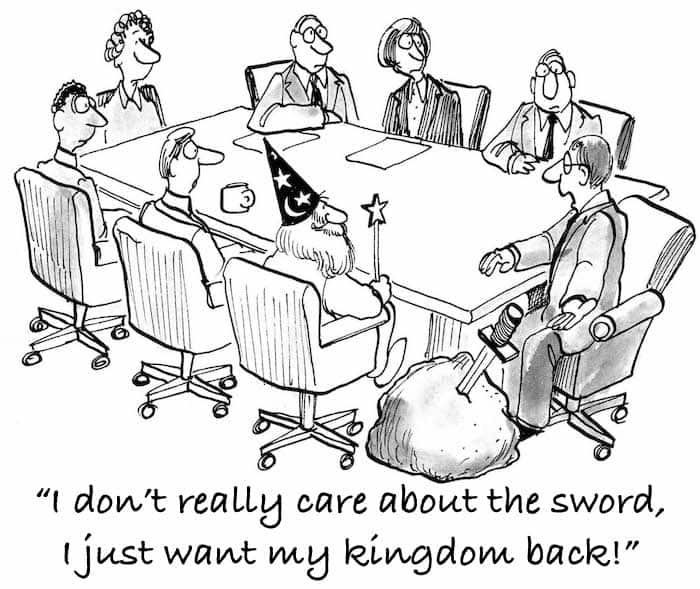You’ve finally got a meeting scheduled with your prospect. (If you missed them, you might want to read about how to get more people to convert on your site, and when to call them to get an initial conversation.) I used to rely on prospects who really wanted to buy— otherwise, I would screw it up. Here are some “secrets” that aren’t actually secret, they just weren’t obvious to me, and I know from talking to other folks with a tech background, that it’s not always obvious.
- Be honest. I don’t simply mean “don’t lie.” I mean, be upfront. The way you would want someone to be when you’re a buyer. If this means you’re not a good fit, so be it. It’s better to learn that at the beginning than waste a bunch of time before the prospect finds out you run your server out of your closet and you’re not actually a multinational corporation with a dedicated support team. The prospect that needs that wasn’t going to buy from you, anyway. But the one that wanted to buy from a small, agile firm won’t buy from you either, if you look like all the other B.S. artists. Plus, lying sucks. So if the answer is “no, it doesn’t do that”, that’s the answer. (You may have a work around, but don’t fudge it.) If the answer is “I don’t know”, say, “I don’t know, but I’ll find out.” People can smell B.S. Plus, you have enough going on in your business— you don’t need to waste brainpower keeping track of lies.
- “Help”, don’t “sell.” Help someone do something they want to do. Don’t sell them something that’s good for you and not so great for them.
- Have an agenda. When you set up the meeting or call, ask what the prospect wants to achieve. If that’s a good fit for you (“wanted to see if you could help us with our widget quality control problem”), just say “great” and put the agenda in the calendar notes. If you need something else (“can we have the production manager on the call, too?”), discuss why it’s important. If they can’t do it, you may have a bad fit, or you may want to reschedule. If the prospect seems tentative, be ready to suggest an agenda that will serve the interests of both parties.
- The purpose of the meeting is not to sell your solution. It’s to figure out if there might be a fit that prompts a sale, or a proposal, or a deeper conversation. When I started, I would get so excited that I’d jump into sales mode. This would screw things up, ruining good opportunities, and causing lots of frustration for both sides. You don’t get married on the first date. Buyers don’t put their companies and their reputations on the line in the first 5 minutes of the first meeting. Get to know them and what they need.
- Getting a “no” is valuable. When I first starting selling, I read a lot about objection handling. I always wanted to turn a polite “maybe” into a “yes.” I wasted a lot of time. Get an answer on the next step quickly. If you go to a heart doctor because you think you have heart problems, and a some questions and tests reveal it’s really a lung problem, you don’t want the heart doctor to say, “well, I really focus on heart surgery, but the lungs are pretty close. I think I can handle this.” If it’s not a good fit, say so. Sometimes, you’ll even get a pleasant surprise— the reason it didn’t seem like a good fit is that the prospect didn’t feel comfortable sharing some things with you, but since you’re about to walk away, they actually want to work with you and open up. Of course, this won’t happen most of the time. And that’s ok. Leave a good impression, and leave. Your opportunity cost for pursuing bad deals is enormous.
- Let the prospect talk. As “experts”, we sometimes feel the need to talk. We don’t. Not until the right time. Going back to the doctor analogy, if a doctor starts talking about heart surgery and how great he is at heart surgery, before we even know if we need heart surgery, this doesn’t help. Your job is to ask questions to understand the real problem. (The prospect may have questions for you, too, which is natural, but avoid going into details, especially technical details. Keep your answers crisp and focused on the business as much as possible.)
- Ask open ended questions. If you help companies with transmogrifiers, it seems natural to ask, “are you having trouble with your transmogrifier?” The problem is, many people do have troubles here, but they’ll say “no”, or maybe even “yes”, but what does that really mean? Instead, you can ask, “how’s your transmogrifier working?” Invite the prospect to invite you into their world. (“Well, pretty good, most of the time, but every once in a while…”) Instead of asking “what’s your budget?”, you can ask, “how do you purchase solutions like this?” Instead of asking, “how many hours per month is your transmogrifier down?”, you can ask, “what were you hoping it would do differently?” You can always ask simpler questions later, but if you force the prospect down your predefined yes/no path, you’ll miss the real issues, and you won’t get good answers to qualify the prospect, or to create a winning proposal.
- Understand three levels of pain. It’s easy to check off a box (“they have big frustrations with their transmogrifier! They’re a great fit!”) and think you have the answers you need, but you’re really just getting started. Don’t stop at the technical level of pain. What are the business implications of the technical problem? And what are the life implications of the business problem? For example, the company may need an integration between 2 systems (technical problem), so that their sales team can spend more time selling instead of doing manual data entry (business problem— many more layers here, but we’ll keep it simple), so that the owner can reach the revenue target she set for herself before selling the company. Who’s more likely to win the deal (and at what price point)— the company that can integrate the systems, or the company that can help the owner retire as a success in her own mind by integrating the systems?
- Understand the decision making process. I lost so many deals that I thought I had won because I didn’t understand the real buying process and I was too naive and/or nervous to ask. So just ask. I get calls from customers at the last minute before a proposal is due, asking me if they should do fixed bid or hourly. These good folks are calling the wrong person. They need to call their prospects. Just ask them, “how do you buy solutions like this?” “What do we need to think about to make sure other stakeholders support this project?”
- Understand how they want to work with you. Are you supposed to be onsite? Offsite? Some mixture? Do they want to have you handle everything and get an email when it’s done? Or are you supposed to sit down with the team and train them? It’s not rocket science, but sometimes people forget to ask these basic questions, so they don’t win the deal.
- Help the prospect with their buying process. This not only means giving them all the information about how awesome you are, but also laying out the risks of the project and what you plan to do about that, including what you need from them. When I started consulting, I tried to sweep this under the rug because I didn’t want to spook buyers. Instead, I just looked like I didn’t know what I was talking about. Later, I learned that buyers often didn’t really know the answers to some of these critical questions, and the ones who were most sure about easy answers had the least information, and were likely to be the hardest cases. So we laid out the risks, and gave buyers different options for dealing with them, so they could make the right trade offs between risk, time, and price.
- Get a commitment for the next step. End a meeting with a clear understand of the next step(s). Send an email to summarize. You started with a clear agenda, you’re ending with a clear agenda. The next step may be “introduce buyer to so-and-so, who’s a much better fit.” That’s a perfectly fine next step. It may be “set up a time to review the proposal you’re about to write”, which is even better. Get a commitment for the next step, even if it’s just letting the prospect socialize your solution. You may find out that the key person was called away on an emergency and you don’t have a real answer, but at least you know the prospect is doing something. In that case, set another commitment.
It sounds like a lot to remember, but it’s mostly about stripping the nonsense out of the sales cycle and being helpful.
—
If you want a convenient, PDF-downloadable version of the checklist, you can grab it below.

